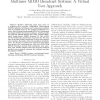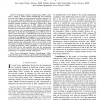17 search results - page 3 / 4 » User Selection for Multiple-Antenna Broadcast Channel with Z... |
VTC
2008
IEEE
14 years 4 days ago
2008
IEEE
—Opportunistic beamforming (OB) relies on the transmission of Channel State Information (CSI) in the form of instantaneous Signal to Noise Ratio (SNR) from Mobile Stations (MSs) ...
WCNC
2008
IEEE
14 years 4 days ago
2008
IEEE
— Besides delivering high data rates in a point-to-point scenario, multi-input multi-output (MIMO) antenna techniques can broadcast personalized data to multiple users in the poi...
TWC
2008
13 years 5 months ago
2008
Abstract--Orthogonal random beamforming (ORB) constitutes a mean to exploit spatial multiplexing and multi-user diversity (MUD) gains in multi-antenna broadcast channels. To do so,...
GLOBECOM
2007
IEEE
14 years 3 days ago
2007
IEEE
— We consider a MIMO line of sight (LOS) broadcast channel where each user has perfect knowledge of its own channel and feeds back ‘quantized’ channel information to the tran...
ICC
2007
IEEE
14 years 2 days ago
2007
IEEE
— Although the capacity of multiple-input multiple output (MIMO) broadcast channels (BCs) can be achieved by dirty-paper coding (DPC), it is difficult to apply the results direct...


